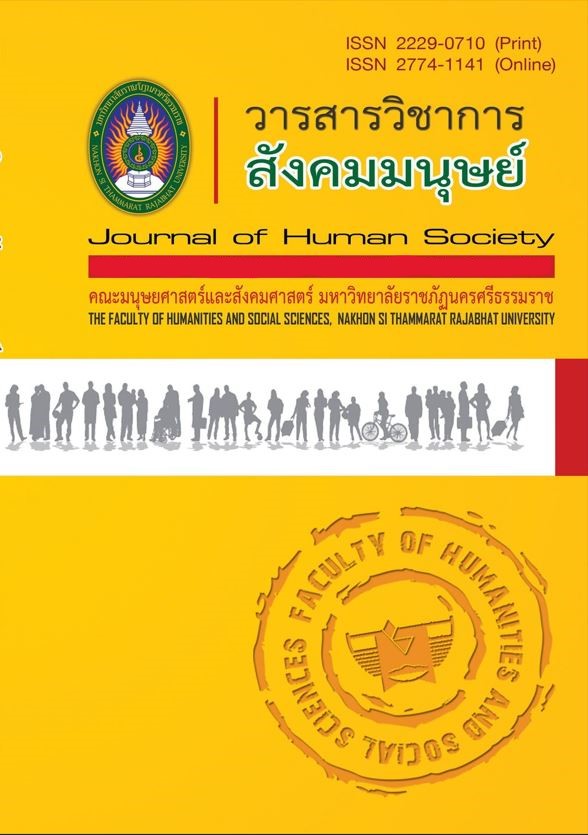Ways of Life and Behavioral Beliefs of Nabon Community
Main Article Content
Abstract
Ways of Life and Behavioral Beliefs of Nabon Community. The objective is to: Study the context and way of Nabon community. Study the behavior of the beliefs of the Nabon community. and to preserve and inherit the beliefs of the Nabon community. Qualitative research methods. We obtained data from: Structured Interview Form interview Participatory and non-participatory observation Focus Group The sample is the elderly, both male and female, aged 20-60 years and above. Practitioners of rituals and beliefs in the Nabon community area We selected 21 specific candidates based on the above qualifications.
The research on professional practices in farming is a qualitative research. Focus on field studies in the Nabon Market community area. It aims to study the contextual conditions and way of Life Nabon community. To study the belief behavior of the Nabon community and to preserve and inherit the beliefs of the Nabon community.
The study found that: The Nabon Chinese community continues to live a life of faith. Traditions, intense and continuous uniqueness, expressed through behavior with interaction. that demonstrates respect for and adherence to
the doctrines and beliefs that have been adhered to in successive practices. As a result, the descendants have been absorbed by their ancestors, which have been observed to date: the worship of the lord at home, and the worship of
the deceased ancestor.
As for the preservation and inheritance of the beliefs of the Chinese community, Nabon found: Organizing activities for the exchange of learning between the younger generation and the older generation. including the transfer of knowledge in information. Images relating to traditions, rituals, beliefs to people in the community or interested parties, resulting in learning and cultural continuity. Succession is continuous and effective.
Article Details

This work is licensed under a Creative Commons Attribution-NonCommercial-NoDerivatives 4.0 International License.
บทความที่ได้รับการตีพิมพ์จะเป็นลิขสิทธิ์ของวารสารวิชาการสังคมมนุษย์
References
กุณฑลีย์ ไวทยะวณิช. (2554). วัฒนธรรมความเชื่อที่เกื้อหนุนการท่องเที่ยวของจังหวัดสงขลา. ดุษฎีนิพนธ์ปรัชญาดุษฎีบัณฑิต สาขาวัฒนธรรมศึกษา มหาวิทยาลัยทักษิณ.
ฉัตรทิพย์ นาภสุภา. (2540). ประวัติศาสตร์ วัฒนธรรมชุมชนและชนชาติไท. กรุงเทพฯ : จุฬาลงกรณ์มหาวิทยาลัย.
ชาย โพธิสิตา. (2550). ศาสตร์และศิลป์แห่งการวิจัยเชิงคุณภาพ. พิมพ์ครั้งที่ 3. กรุงเทพมหานคร: อมรินทร์พริ้นติ้ง.
ชื่น ศรีสวัสดิ์ และเกริกไกร แก้วล้วน. (2550). การท่องเที่ยวเชิงวัฒนธรรม: กรณีศึกษาวัฒนธรรมชุมชนของ ชาวกวยในเขตอีสานใต้และลาวใต้. สำนักงานกองทุนสนับสนุนการวิจัย (สกว.).
ชลอ บุญช่วย. (2530). ความเชื่อที่ปรากฏในพิธีกรรมของชาวไทยเชื้อสายจีนอำเภอเมือง จังหวัดสงขลา.วิทยานิพนธ์ปริญญามหาบัณฑิต มหาวิทยาลัยศรีนครินทรวิโรฒ สงขลา.
ธวัชชัย ท้องสมุทร์. (2558). วิถีชีวิตชาวใต้. ศิลปนิพนธ์ ศษ.บ. (สาขาวิชาศิลปศึกษา). ปัตตานี : มหาวิทยาลัยสงขลานครินทร์.
ปรีชา สามัคคี และปัญญา เลิศไกร. (2557). การสังเกต 360 องศาเพื่อการวิจัยและพัฒนา. วารสารนาคบุตรปริทรรศน์ ปีที่ 6 ฉบับที่ 1 มกราคม-มิถุนายน นครศรีธรรมราช : มหาวิทยาลัยราชภัฏนครศรีธรรมราช, น.58-66.
ปาริชาติ วลัยเสถียร และคณะ. (2546). กระบวนการและเทคนิคการทำงานของนักพัฒนา. โครงการเสริมสร้างความรู้เพื่อชุมชนเป็นสุข (สรส.). กรุงเทพฯ.
ปิยชาติ สึงตีและสิรีธร ถาวรวงศา. (2553). ประวัติศาสตร์และวัฒนธรรมของกลุ่มชาวจีนฮกจิวในภาคใต้ของประเทศไทย : กรณีศึกษาชุมชนชาวจีนฮกจิวอำเภอนาบอนจังหวัดนครศรีธรรมราช. สำนักงานคณะกรรมวัฒนธรรมแห่งชาติ กระทรวงวัฒนธรรม.
ปฐม หงส์สุวรรณ. (2556). นานมาแล้ว มีเรื่องเล่า นิทาน ตำนาน ชีวิต. กรุงเทพมหานคร :
โรงพิมพ์แห่งจุฬาลงกรณ์มหาวิทยาลัย
พัชรี ทองเรือง. (2561). การจัดการเรียนรู้ชุมชน. วารสารวิชาการสังคมมนุษย์ คณะมนุษยศาสตร์และสังคมศาสตร์ มหาวิทยาลัยราชภัฏนครศรีธรรมราช ปีที่ 8 ฉบับที่ 2 กรกฎาคม-ธันวาคม 2561.
พวงเพชร สุรัตนกวีกุล. (2544). มนุษยกับสังคม. (พิมพครั้งที่ 3). กรุงเทพฯ : มหาวิทยาลัยเกษตรศาสตร์.
ลัญจกร นิลกาญจน์. (2561). วัฒนธรรมความเชื่อกับการจัดการศรัทธาของชุมชน. วารสารนาค บุตรปริทัศน์ปีที่ 10 ฉบับที่ 2 เดือนกรกฎาคม - ธันวาคม 2561
วรรณพร อนันตวงศ์, เก็ตถวา บุญปราการ, และปัญญา เทพสิงห์. (2561). วิถีชีวิตและอัตลักษณ์ของชุมชนคีรีวง. การประชุมหาดใหญ่วิชาการระดับชาติและนานาชาติ ครั้งที่ 9
สุพัตรา สุภาพ. (2543). สังคมและวัฒนธรรมไทย :ค่านิยม : ครอบครัว : ศาสนา : ประเพณี. (พิมพ์ครั้งที่11). กรุงเทพฯ: ไทยวัฒนาพานิช.
เสริมศักดิ์ ขุนพล. (2557). การศึกษาอัตลักษณ์ทางวัฒนธรรม ความเชื่อของชุมชนเกาะยอ. วารสารปาริชาต มหาวิทยาลัยทักษิณ. ปีที่ 28 ฉบับที่ 3 (ฉบับพิเศษ)
สมปราชญ์ อัมมะพันธ์. (2536). ประเพณีและพิธีกรรมในวรรณคดีไทย. กรุงเทพมหานคร:
อาหมัดอัลซารีย์ มูเก็ม. (2559). ประเพณี พิธีกรรม ความเชื่อ ที่มีความสัมพันธ์ต่อวิถีชีวิต ของชนกลุ่มชาติพันธุ์เขมรบน พื้นที่บ้านจารย์ อําเภอสังขะ จังหวัดสุรินทร์. ประกาศนียบัตรบัณฑิต สาขาวิชาบัณฑิตอาสาสมัคร วิทยาลัยพัฒนศาสตร์ ป๋วย อึ๊งภากรณ์ มหาวิทยาลัยธรรมศาสตร์.
Bat en, T. R. (1959). Community and their development. London: Oxford University Press.
Chris Barker. (2012). Cultrual Studies. California: SAGE publication Inc.
Gillian Symon and Catherine Cassell (2012). Qualitative Organizational Research Core Methods and Current Challenges. California: Sage Publications Inc
Punya Lertgrai, Lunjakon Nillakan, Nilrat Navakijpaitoon and Kittaporn Sae-Ngae Sai-Jun. (2020). WISDOM MANAGEMENT OF POLYCULTURE IN HOUSEHOLDS AT BAN NA NGAE, NA RENG SUB-DISTRICT, NOPPHITAM DISTRICT, NAKHON SI THAMMARAT PROVINCE. Hamdard Islamicus,Vol. 43 (2). 947-959. Website: https://hamdardfoundation.org/hamdard Islamicus/ (scopus)

